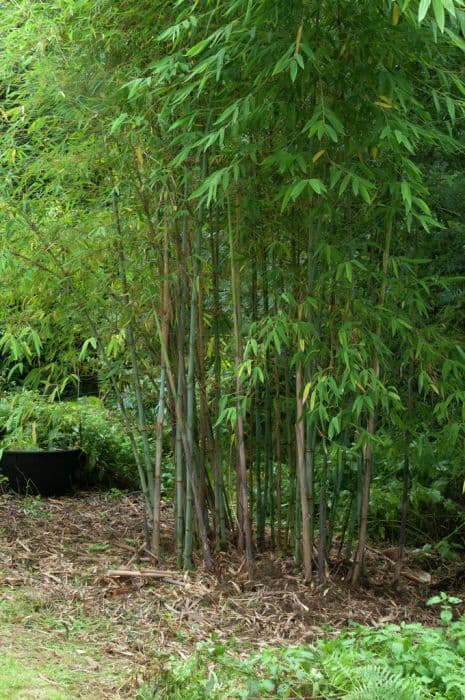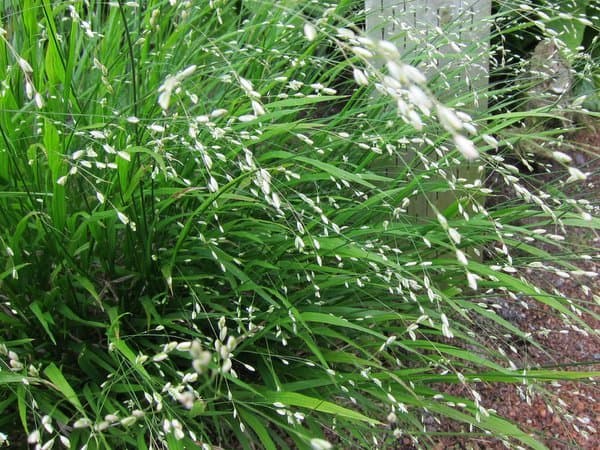Quaking Grass Briza media 'Golden Bee'











ABOUT
The Briza media 'Golden Bee' is commonly known as "Quaking grass". This ornamental grass is admired for its delicate, pendant, heart-shaped seed heads that dangle gracefully from thin stems, creating a soft, airy texture in the landscape. Its foliage forms a dense, clumping tuft, providing a lush green backdrop for the shimmering seed heads which, with time, turn to a golden hue as they mature. The gentle movement of the seed heads with the slightest breeze adds a dynamic quality to the plant's presence, often creating a sound similar to a gentle rustling or soft whispers. The leaves of Quaking grass are slender and blade-like, with a subtle shade of green that can have tints of blue or grey depending on the lighting and environment. In the peak of its growing season, this grass displays a textural contrast with the surrounding garden foliage, offering a unique visual interest with its distinct form and whimsical nodding action. The overall visual effect of the Golden Bee cultivar is one of elegance and charm, making it a sought-after choice for gardens aiming for a naturalistic or cottage garden style.
About this plant
 Names
NamesFamily
Poaceae
Synonyms
Golden Bee Quaking Grass, Golden Bee Rattlesnake Grass, Golden Bee Common Quaking Grass
Common names
Briza media.
 Toxicity
ToxicityTo humans
Quaking grass is generally not considered toxic to humans. There are no well-documented cases of poisoning from ingesting quaking grass, and it is not commonly known to cause any adverse effects if accidentally consumed in small quantities. Always exercise caution and avoid eating plants that are not specifically intended for human consumption.
To pets
Quaking grass is not known to be toxic to pets. There are no significant reports of pet poisoning from ingesting this grass. As with humans, it is still advisable to prevent pets from eating ornamental plants since they may cause digestive upset or other non-toxic related issues if consumed in larger amounts.
 Characteristics
CharacteristicsLife cycle
Perennials
Foliage type
Deciduous
Color of leaves
Green
Height
1-2 feet (30-60 cm)
Spread
1 foot (30 cm)
Plant type
Grass
Hardiness zones
4
Native area
Europe
Benefits
 General Benefits
General Benefits- Aesthetic Appeal: Briza media 'Golden Bee', commonly known as Quaking Grass, has delicate, nodding seed heads that add texture and movement to the garden, especially when they catch sunlight and sway in the breeze.
- Low Maintenance: Quaking Grass is known for being easy to care for, requiring minimal attention once established in the appropriate climate and soil conditions.
- Drought Tolerance: This plant is relatively drought-tolerant, making it suitable for xeriscaping or gardens in drier climates where water conservation is important.
- Wildlife Attraction: The seeds of Quaking Grass provide food for birds, while its structure offers shelter to various small insects and wildlife.
- Seasonal Interest: It features a long period of visual interest from the flowering stage in spring/early summer to the golden-brown hue it takes on in autumn and winter.
- Versatility in Landscaping: The plant can be used in a variety of landscaping designs, including meadow planting, borders, rock gardens, and as a filler in mixed beds.
- Non-Invasiveness: Quaking Grass tends to grow in well-defined clumps and does not aggressively spread, making it a safe choice for gardeners who want to prevent unwanted spreading.
 Medical Properties
Medical PropertiesThis plant is not used for medical purposes.
 Air-purifying Qualities
Air-purifying QualitiesThis plant is not specifically known for air purifying qualities.
 Other Uses
Other Uses- Quaking grass can be used in dried flower arrangements due to its pendulous spikelets that add movement and a unique texture, maintaining their shape and color for extended periods.
- The seeds of quaking grass can serve as a food source for birds, particularly during the winter months when other food is scarce.
- This grass is sometimes used in landscaping as a ground cover to prevent soil erosion on slopes and banks due to its dense growth.
- Its gentle rustling sound when moved by the wind provides an auditory element to sensory gardens, aiding in relaxation and stress relief.
- Quaking grass can be incorporated into educational projects and botanical studies, perfect for students studying plant structure and reproduction.
- The grass’s visual appeal throughout seasons, including frost-covered seed heads in winter, makes it ideal for year-round garden interest.
- It can also be included in wildlife-friendly gardens to attract and provide habitat for small mammals and insects.
- Quaking grass may be used in themed gardens that focus on native plants, historic gardens, or prairie-style landscapes.
- The leaves of quaking grass can be used for low-grade forage for grazing animals when mixed with other grasses, although it is not the preferred forage.
- Artists and crafters use quaking grass for natural art installations, sculptures, and botanical crafts due to its unique shape and form.
Interesting Facts
 Feng Shui
Feng ShuiQuaking grass is not used in Feng Shui practice.
 Zodiac Sign Compitability
Zodiac Sign CompitabilityQuaking grass is not used in astrology practice.
 Plant Symbolism
Plant Symbolism- Peace: The gentle nodding of Briza media's seed heads in the breeze evokes a sense of calm and tranquility, representing peace.
- Flexibility: The way the stems sway flexibly without breaking symbolizes the importance of being adaptable to change.
- Resilience: Despite its delicate appearance, Briza media can withstand various conditions, signifying resilience and the ability to endure challenges.
- Harmony with Nature: The grass's easy integration into wild landscapes expresses a desire to live in balance with the natural world.
 Water
WaterThe Quaking Grass should be watered moderately, ensuring the soil is kept moist but not waterlogged. During the growing season, water the plant with approximately 1 gallon per week, adjusting for rainfall, and reduce this amount during the winter months when the plant is not actively growing. Overwatering can lead to root rot, so it's important to allow the soil to dry out slightly between watering sessions. For potted plants, water until you see excess water draining from the bottom of the pot.
 Light
LightQuaking Grass thrives in full sun to partial shade conditions. The ideal spot for this plant would be in a location where it receives at least 4 to 6 hours of sunlight daily. It can tolerate some light afternoon shade, especially in hotter climates, which can prevent the foliage from scorching.
 Temperature
TemperatureQuaking Grass prefers moderate temperatures and can generally survive in temperatures ranging from 40 degrees Fahrenheit to 80 degrees Fahrenheit. However, the ideal temperature for optimal growth falls between 60 degrees Fahrenheit and 70 degrees Fahrenheit. This plant can handle light frosts, but prolonged exposure to temperatures below 40 degrees Fahrenheit can be detrimental.
 Pruning
PruningPruning Quaking Grass is done primarily to remove dead or faded foliage and to maintain its neat appearance. Prune in early spring before new growth begins, cutting back the old foliage to a few inches above the ground. This timing encourages healthy new growth and can be done annually as part of the plant's maintenance routine.
 Cleaning
CleaningAs needed
 Soil
SoilQuaking Grass requires well-drained soil with a pH range of 6.0 to 7.5. A mix of loamy soil, peat, and sand is ideal, ensuring good drainage and aeration. Enrich with organic matter to support growth.
 Repotting
RepottingQuaking Grass typically doesn't require frequent repotting. It can be repotted every two to three years or when it becomes root-bound to maintain health and vigor.
 Humidity & Misting
Humidity & MistingQuaking Grass thrives in average humidity conditions. It does not have specific humidity requirements, making it adaptable to normal indoor humidity levels.
 Suitable locations
Suitable locationsIndoor
Place Quaking Grass near a bright window, away from direct sunlight.
Outdoor
Plant Quaking Grass in full sun to partial shade, in fertile soil.
Hardiness zone
4-9 USDA
 Life cycle
Life cycleCommonly known as Golden Bee Quaking Grass, Briza media 'Golden Bee' begins its life cycle as a seed, typically germinating in the spring when soil temperatures and moisture levels are conducive to growth. The seedlings establish themselves with a clump-forming habit, developing into a rosette of narrow, green to golden-yellow leaves. As the plant matures, it sends up flowering stems in late spring to early summer, bearing delicate, pendulous seed heads that quake or rattle in the wind. After pollination, these flowers set seed which ripen by late summer. The plant then enters a period of dormancy in the fall and winter, during which above-ground growth dies back while the root system remains alive. Golden Bee Quaking Grass completes its life cycle when the seeds disperse and potentially give rise to new plants the following spring, continuing the cycle.
 Propogation
PropogationPropogation time
Spring-Early Summer
Briza media 'Golden Bee', commonly known as Quaking Grass, is predominantly propagated through seed. The best time to sow the seeds is in the spring after the danger of frost has passed, or in early autumn. To propagate, prepare a well-draining soil mix and scatter the seeds on the surface, pressing them gently into the soil. It's not necessary to cover the seed with soil, but a light sprinkling can help retain moisture. Water the area gently to moisten the soil without displacing the seeds. Keep the soil consistently moist until germination, which typically occurs within two to three weeks. Quaking Grass can also self-seed in suitable growing conditions, allowing for natural propagation in the garden.









